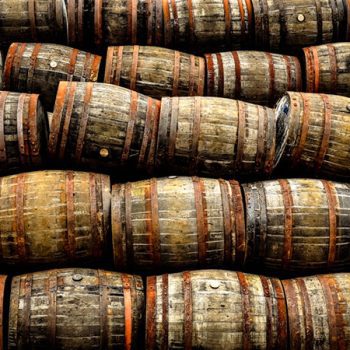Lean times: investigating whisky production pauses
By Nicola CarruthersThe post-pandemic consumption boom led to a surge in sales, with distilleries ramping up production to meet demand. But now, amid shifting market dynamics, many are scaling down to survive.

After years of double-digit gains during the Covid-19 pandemic, the spirits industry has started to see a slowdown in growth, and many distilleries have responded with production pauses, job cuts, and some even filing for bankruptcy.
Over the past 12 months, the industry has seen major distillers scale back on production, something that has particularly affected whisky makers.
Among them was third-party producer MGP Ingredients in the US, Scottish distilleries Glenglassaugh and Isle of Harris, and Irish whiskey makers Midleton Distillery, Tullamore, and Dublin Liberties Distillery. There are likely more producers that have taken this action but have not disclosed the fact.
Bourcard Nesin, vice-president of research for beverages at Rabobank, believes this is not limited to the whisky industry. “The problem with oversupply is almost universal in the bevalc industry. It’s affecting Bourbon, American whiskey, Tequila, it’s affecting wine, not just in the US but around the globe, and even brewers,” he explains.
Nesin sheds some light on why oversupply is happening: “One was a function of bad forecasting. A lot of spirits companies saw all the growth from the pandemic, and ambitiously made the mistake of thinking that would continue.” He explains that many companies “built production and inventory” to meet the “big boom in consumption” when consumers were stuck at home. He notes there was a huge amount of uncertainty in supply chains that led to “out of stock” situations.
“But as supply chains smoothed out, we ended up seeing too much inventory at all levels of the system. We saw interest rates grow, which forced everyone along the supply chain to rationalise inventories below pre-pandemic levels because the interest rates mean that carrying inventory costs more, and if it costs more, you should have less of it,” Nesin warns.
He adds that this “aggressive forecasting and sourcing” came up against a “massive decline in demand” that he believes was predictable. “These companies are sitting on far more inventory than they need at the moment.”
However, he adds that it’s a “different scenario for big brands versus small brands” because as companies sit on inventory, their working capital incrementally increases. “Maybe costs in the future are going to be lower because they’ve already invested into that inventory,” he says, adding that this could result in a short-term hit to profitability and future improvements to profits. “But this increase in inventory is going to have a negative pressure on pricing. The question is how severe is that [pricing impact], and which segments of the market are going to be most affected?
In answering this question, Nesin believes there will be “a lot of downward pressure on more niche premium categories and craft spirits” that are “more product-forward and less brand-forward”.
Nesin says the oversupply issue is particularly severe for products that have longer production cycles, like Scotch and Irish whiskey, as well as Tequila, which is typically made from agave grown for seven years. “It’s how long is the window between when you have to lay down inventory or production capacity, in this case agave or a barrel of Scotch, versus when that will be consumed?”
He says the oversupply issue is leading to more aged, high-quality inventory coming onto the market at lower prices, benefitting consumers. However, he warns, this could cause “significant damage” for smaller, premium brands.
Margie AS Lehrman, CEO of trade body the American Craft Spirits Association (ASCA), highlights the “highly complex regulatory system” that brands are faced with in the US. “Restrictions on how you get product to market are so much harder,” when compared with wine and beer, she says. “Opening a distillery is harder, and more expensive. Distribution remains one of the primary chokeholds. Only a dozen states have passed direct-to-consumer [spirits] shipping.”

She also cites other challenges for spirits producers, such as the forthcoming updates to US dietary guidelines, and what that could mean for alcohol, issues around labelling, including the increased cost of potentially adding nutritional and allergen information to bottles, and increased competition from non-alcoholic brands. US president Donald Trump has also threatened varying levels of tariffs on imports to the US, potentially throwing another spanner in the works for spirits.
Major drinks conglomerates have not been immune to the downturn in spirits sales. In January this year, Brown-Forman announced it would reduce its 5,400-strong global workforce by approximately 12%, and close its cooperage in Kentucky by 25 April.
In March, Diageo announced it would no longer be bringing new brands into the Distill Ventures accelerator programme, which resulted in job losses. This led to a 25% reduction in jobs at Danish distillery Stauning, while American single malt maker Westward filed for voluntary bankruptcy protection. Both companies were part of Distill Ventures’ investment programme.
In May, the Financial Times reported that Moët Hennessy (LVMH’s wine and spirits arm) plans to cut its workforce by 10%, equal to around 1,200 people.
Spiros Malandrakis, head of research – alcoholic drinks at Euromonitor International, believes there has been a shift from premium, aspirational products to “more polarised offerings”. He says premiumisation will “continue for certain demographics in certain occasions and environments” but he says “mass products are gaining some momentum for the first time in a long time”.
This would cause a slowdown for distilleries “doubling down on the premiumisation narrative”, he says, meaning this would have a trickle-down effect to job numbers.
Sellers divest brands
Can we expect to see more consolidation in the industry? Just last month Scotch producer Loch Lomond Group purchased New York Distilling Co. However, Nesis says: “There’s no buyer for bad brands at the moment. A lot of the largest sellers are divesting their own brands rather than the other way round. It’s the same thing with the inventories, the valuation of a smaller craft distillery or brand without scale, without strong growth, without excellent inventory, is getting dangerously close to zero because there is no buyer for that product, for that business, and that just means we’re going to have fewer manufacturers and brands in the short term.”
In May, Campari said it would streamline its portfolio and not seek further acquisitions.
In the ACSA’s last Craft Spirits Data Project report, released in September 2024, the number of active craft distilleries in the US increased by 11.5%, despite noting a significant number of craft distillery closures. Lehrman says this year’s edition of the report is in the works, and will provide insights into the current state of inventory in the industry, including the number of active distilleries. Lehrman believes the “biggest win” for craft spirits would be brands in more states having the ability to ship direct to consumers.
Lehrman would also like to see more support from the US government for the industry. “I do believe we will see significant changes in the next decade in what the spirits industry will look like,” she says. “The federal government has a role to play in shaping that.”
Related news
Diageo halts production at Balcones and George Dickel
